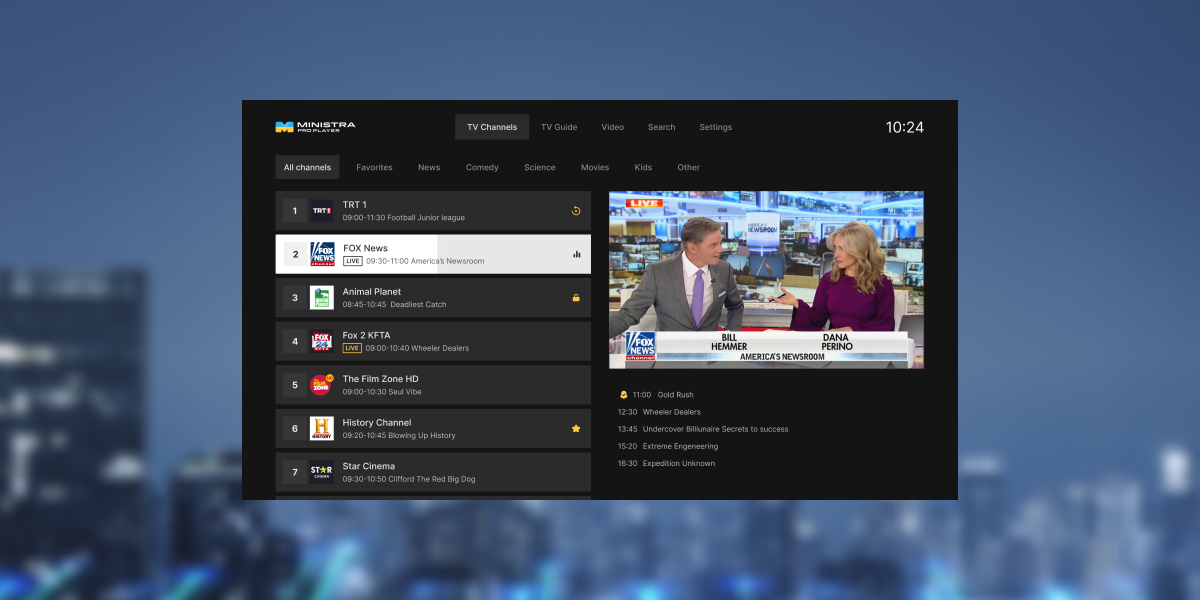As viewers increasingly shift towards online streaming services, cable TV operators face the need to evolve and remain competitive. Among the various OTT (Over-The-Top) solutions available, IPTV (Internet Protocol Television) stands out as a cost-effective and efficient way to deliver television content over the Internet.
For operators considering this transition, Linux-based set-top boxes present a versatile, scalable, and budget-friendly solution. In this article, we’ll explore the steps to transition seamlessly to IPTV and highlight the benefits of using Linux-based set-top boxes.
IPTV and Linux boxes benefits
Transitioning to Internet Protocol Television allows operators to distribute content over current broadband networks, bypassing the traditional limitations of satellite or cable TV. To use this type of service, the end user only needs internet access and a set-top box. When considering set-top box IPTV solutions, we believe that the best option is a Linux box, as the device offers flexible customizability and lower operating costs for the operator.
The device also provides customers with access to features that traditional broadcasting methods can’t offer:
Content on Demand (VoD) — users choose when and what content they watch.
Deferred TV (TimeShift) lets you rewind and pause content. If the viewer turns on the channel in the middle of a program, the service allows the user to return to the beginning.
Electronic Program Guide (EPG) informs the user when and on which channel movies, news, shows, and series are shown. Subscribers can see which programs are on now, and which ones have already ended or will be broadcast later.
Note that by forming their own pool of users’ Linux boxes, IPTV service operators get long-term savings. The devices use open-source code, which reduces the cost of license fees. Additionally, the OS itself offers robust support communities and provides effective control over system updates and settings.
Switching from cable to IPTV

Cable and interactive television broadcasting have several fundamental differences, both in the content delivery method and in its acquisition, use and distribution. To make IPTV and OTT integration as effective as possible, operators should pay particular attention to several key stages. Let’s talk about them and the cable TV to IPTV shift in more detail.
Network infrastructure assessment: cable operator modernization involving IPTV requires a stable, high-speed Internet infrastructure. Cable operators often use coaxial cable, so it’s important to assess current network capabilities. It’s also important to upgrade existing infrastructure to fiber optic lines or improved broadband communications.
Choosing compatible middleware: the efficiency of an IPTV service depends on the middleware. This is kind of the “core” of the whole system, which manages content delivery, analytic systems, billing, and interacts with the user interface (UI). If an operator has chosen Linux devices for its set-top box pool, the middleware should be compatible with them. One such middleware for IPTV is Ministra Pro. It is a complete solution for IPTV/OTT operators that has already proven itself in the market.

Compliance and licensing: because IPTV is Internet-based, operators must comply with digital rights management (DRM) and regional content rules, some of which can be quite different from the traditional cable licensing rules.
Setting up and integrating Linux boxes
When choosing Linux boxes, always look to see which OS version is being used. For example, Raxxio’s MAG devices run Linux 4.9. Operators choose these devices for their IPTV projects because of their modularity, security, and customizability, as well as compatibility with various middleware and security protocols.
In order to stream IPTV to set-top boxes, the software must be configured. This includes network configuration and system settings to minimize delays and ensure smooth video playback. This setting may include caching configurations and packet loss prevention mechanisms.
The user interface plays an important role in user satisfaction. Linux set-top boxes provide the flexibility to create a customizable user interface that can integrate popular applications, provide easy access to channels, and support many additional features.
Advanced Linux set-top box features
The Linux OS can offer operators integration of OTT and application support. For example, YouTube or local streaming services can be integrated into Linux boxes. This will help increase user satisfaction and make the service more competitive.
In addition, operators can use Linux-based solutions to provide a seamless experience across devices, allowing users to easily pause content playback on a TV and resume it on a smartphone.
Linux devices can support targeted advertising features and collect viewer analytics to offer personalized content and advertising, increasing their value for advertisers and growing potential revenue for operators.
Staff training and tech support for end users
Successful IPTV deployments require technical support teams well-versed in Linux, including familiarity with remote troubleshooting, system upgrades, and user interface customizations.

Of course, as part of the IPTV migration process, some customers moving from cable TV may need assistance in adapting to IPTV features. Providing user guides, video tutorials, and responsive customer support can all be helpful to increase customer satisfaction and loyalty.
Updates and upgrades
Utilizing open-source Linux allows operators to continually receive security updates, system upgrades, and feature enhancements. This is especially helpful for operators who want to stay ahead of the curve in the dynamic digital marketplace.
As technologies such as 4K and HDR become standard, Linux boxes can be scaled up or replaced with newer hardware as needed, ensuring operators can keep up with changing industry standards.
The move to an IPTV setup for operators with Linux boxes is an ideal way to meet the expectations of today’s viewers, not to mention the fact that it is also cost-effective. Although there are some IPTV deployment challenges when switching to Linux-powered streaming devices, with thoughtful planning, quality infrastructure, and expert service, operators will be able to stay competitive and create a flexible, feature-rich viewing experience.

